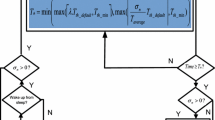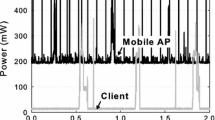Abstract
With the rapid development of Internet and wireless communication technology, ubiquitous network services become more and more popular. WiMAX is widely used to solve the last mile in network deployment. To enhance the mobility, mobile WiMAX is launched to support the mobile usages. Due to the limited power of mobile devices, power saving becomes a key issue for mobile WiMAX applications. Though plenty of efforts have been proposed to save power on the mobile devices, the problems are partially solved. Among others, sleep mode operations are widely adopted to save power in wireless communications. Generally, longer sleep time can reduce power consumption at the cost of increased packet response delay. To improve the quality of services, an adaptive power saving scheme for mobile WiMAX is proposed in this paper. Parameters related to power management are dynamically set according to current network traffic load. The analyses and simulation results show that the proposed scheme presents superior power efficiency and packet response delay in the context of mobile WiMAX.
Similar content being viewed by others
References
Andrews J. G., Ghosh A., Muhamed R. (2007) Fundamentals of WiMAX: Understanding broadband wireless networking. Prentice Hall, Englewood Cliffs, NJ
Jones C. E., Sivalingam K. M., Agrawal P., Chen J. C. (2001) A survey of energy efficient network protocols for wireless networks. ACM Wireless Networks 7(4): 343–358
Bambos N. (1998) Toward power-sensitive network architectures in wireless communications: Concepts, issues, and design aspects. IEEE Personal Communications 5(3): 50–59
Sheth, A., & Han, R. (2003). Adaptive power control and selective radio activation for low-power infrastructure mode 802.11 LANs. In Proceedings of IEEE ICDCSW, pp. 812–818.
Ye W., Heidemann J., Estrin D. (2004) Medium access control with coordinated adaptive sleeping for wireless sensor networks. IEEE/ACM Transactions of Networking 12(3): 493–506
Wei, T., Chandra, S., & Bhandarkar, S. (2004). A statistical prediction-based scheme for energy-aware multimedia data streaming. In Proceedings of IEEE WCNC, pp. 2053–2057.
IEEE Std 802.16-2004. (2004). IEEE standard for local and metropolitan area networks—part 16: Air interface for fixed broadband wireless access systems.
IEEE Std 802.16e-2005. (2006). IEEE standard for local and metropolitan area networks—part 16: Air interface for fixed and mobile broadband wireless access systems—amendment 2: Physical and medium access control layers for combined fixed and mobile operation in licensed bands.
Cho, S., & Kim, Y. (2007). Improving power savings by using adaptive initial-sleep window in IEEE 802.16e. In Proceedings of IEEE 65th vehicular technology conference, pp. 1321–1325.
Kim M. G., Choi J., Kang M. (2007) Adaptive power management mechanism considering remaining energy in IEEE 802.16e. IEICE Transactions on Communication E90-B(9): 2621–2624
Kim, M. G., Kang, M., & Choi, J. (2008). Remaining energy-aware power management mechanism in the 802.16e MAC. In Proceedings of IEEE 5th consumer communication and networking conference, pp. 222–226.
Kim M. G., Choi J., Kang M. (2008) Adaptive power saving mechanism considering the request period of each initiation of awakening in the IEEE 802.16e system. IEEE Communication Letters 12(2): 106–108
Jeong D. G., Jeon W. S. (2006) Performance of adaptive sleep period control for wireless communications systems. IEEE Transactions on Wireless Communications 5(11): 3012–3016
Lee J. R., Cho D. H. (2007) Performance evaluation of energy-saving mechanism based on probabilistic sleep interval decision algorithm in IEEE 802.16e. IEEE Transactions on Vehicular Technology 56(4): 1773–1780
Zhu, S., Ma, X., & Wang, L. (2007). A delay-aware auto sleep mode operation for power saving WiMAX. In Proceedings of 16th international conference computer communication and networks, pp. 997–1001.
Lin Y. B., Chuang Y. M. (1999) Modeling the sleep mode for cellular digital packet data. IEEE Communication Letters 3(3): 63–65
Kwon S. J., Chung Y. W., Sung D. K. (2003) Queueing model of sleep-mode operation in cellular digital packet data. IEEE Transactions on Vehicular Technology 52(4): 1158–1162
Niu, Z., Zhu, Y., & Benetis V. (2007). A phase-type based Markov chain model for IEEE 802.16e sleep mode and its performance analysis. In Proceedings of 20th international teletraffic congress, Ottawa, Canada.
Seo J. B., Lee S. Q., Park N. H., Lee H. W., Cho C. H. (2004) Performance analysis of sleep mode operation in IEEE 802.16e. Proceedings of VTC2004 2: 1169–1173
Xiao Y. (2005) Energy saving mechanism in the IEEE 802.16e wireless MAN. IEEE Communications Letters 9(7): 595–597
IEEE 802.16e/D3. (2004). Part 16: Air interface for fixed and mobile broadband wireless access systems—amendment for physical and medium access control layers for combined fixed and mobile operation in licensed bands.
Xiao, Y. (2006). Performance analysis of an energy saving mechanism in the IEEE 802.16e wireless MAN. In Proceedings of IEEE 3 rd consumer communication and networking conference (Vol. 1, pp. 406–410).
Zhang, Y. (2007). Performance modeling of energy management mechanism in IEEE 802.16e mobile WiMAX. In Proceedings of IEEE wireless communications and networking conference, pp. 3205–3209.
Liu, J., Ren, F., & Lin, C. (2010). A dual-threshold power saving mechanism in WiMAX. In Proceedings of 2010 IEEE/ACIS 9th international conference on computer and information science (ICIS), pp. 465–470.
Liao W. H., Yen W. M. (2009) Power-saving scheduling with a QoS guarantee in a mobile WiMAX system. Journal of Network and Computer Applications 32: 1144–1152
Averaging and exponential smoothing models. Available at http://www.duke.edu/~rnau/411avg.htm (Notes for a statistics class (Decision 411) at Duke University).
Author information
Authors and Affiliations
Corresponding author
Rights and permissions
About this article
Cite this article
Lin, YW., Wang, JS. An Adaptive QoS Power Saving Scheme for Mobile WiMAX. Wireless Pers Commun 69, 1435–1462 (2013). https://doi.org/10.1007/s11277-012-0644-0
Published:
Issue Date:
DOI: https://doi.org/10.1007/s11277-012-0644-0




